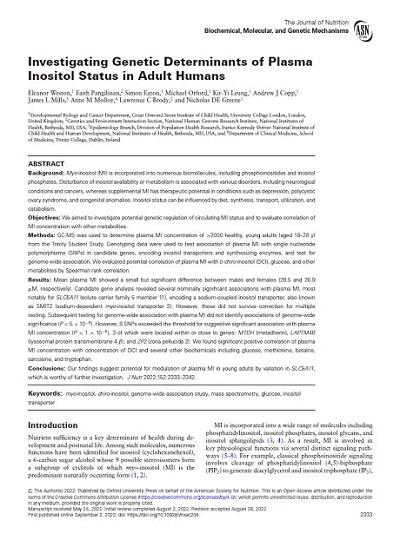Authors:
Eleanor Weston, Faith Pangilinan, Simon Eaton, Michael Orford, Kit-Yi Leung, Andrew J Copp, James L Mills, Anne M Molloy, Lawrence C Brody, Nicholas DE Greene
Background: Myo-inositol (MI) is incorporated into numerous biomolecules, including phosphoinositides and inositol
phosphates. Disturbance of inositol availability ormetabolism is associated with various disorders, including neurological conditions and cancers, whereas supplemental MI has therapeutic potential in conditions such as depression, polycystic ovary syndrome, and congenital anomalies. Inositol status can be influenced by diet, synthesis, transport, utilization, and catabolism.
Objectives: We aimed to investigate potential genetic regulation of circulating MI status and to evaluate correlation of
MI concentration with other metabolites.
Methods: GC-MS was used to determine plasma MI concentration of >2000 healthy, young adults (aged 18–28 y)
from the Trinity Student Study. Genotyping data were used to test association of plasma MI with single nucleotide
polymorphisms (SNPs) in candidate genes, encoding inositol transporters and synthesizing enzymes, and test for
genome-wide association.We evaluated potential correlation of plasmaMI with D-chiro-inositol (DCI), glucose, and other metabolites by Spearman rank correlation.
Results: Mean plasma MI showed a small but significant difference between males and females (28.5 and 26.9
μM, respectively). Candidate gene analysis revealed several nominally significant associations with plasma MI, most
notably for SLC5A11 (solute carrier family 5 member 11), encoding a sodium-coupled inositol transporter, also known
as SMIT2 (sodium-dependent myo-inositol transporter 2). However, these did not survive correction for multiple
testing. Subsequent testing for genome-wide association with plasma MI did not identify associations of genome-wide
significance (P < 5 × 10−8). However, 8 SNPs exceeded the threshold for suggestive significant association with plasma MI concentration (P < 1 × 10−5), 3 of which were located within or close to genes: MTDH (metadherin), LAPTM4B (lysosomal protein transmembrane 4 β), and ZP2 (zona pellucida 2). We found significant positive correlation of plasma MI concentration with concentration of DCI and several other biochemicals including glucose, methionine, betaine, sarcosine, and tryptophan.
Conclusions: Our findings suggest potential for modulation of plasma MI in young adults by variation in SLC5A11,
which is worthy of further investigation. J Nutr 2022;152:2333–2342.

